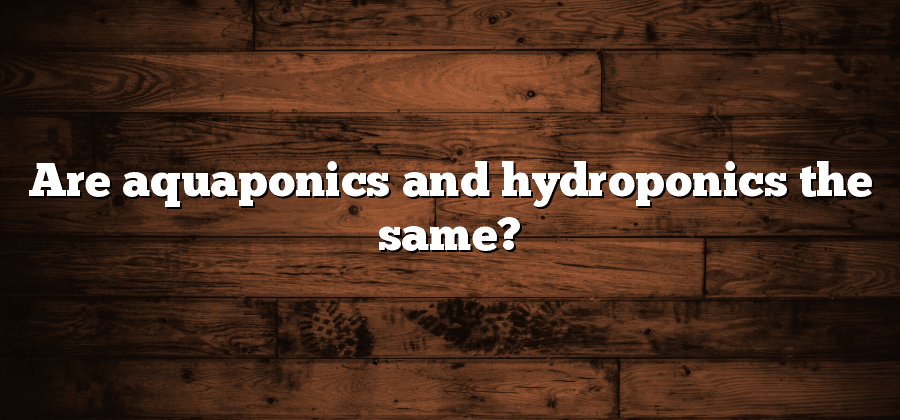Aquaponics vs Hydroponics: What’s the Difference?
Aquaponics and hydroponics are two popular methods of growing plants in controlled environments, but they differ significantly in their approach and function. Aquaponics is a system that combines the cultivation of plants and fish in a symbiotic relationship. It incorporates aquaculture, where fish waste serves as a nutrient-rich fertilizer for plants, and hydroponics, where plants grow without soil. This integrated system allows for a closed-loop, sustainable approach to food production, as it utilizes the waste from fish to nourish plants, which in turn clean the water for the fish.
On the other hand, hydroponics focuses solely on growing plants in water without the presence of fish or other aquatic creatures. In hydroponics, the plants receive a carefully balanced nutrient solution directly in the water, providing them with all the necessary elements for growth. This method eliminates the need for soil and allows for precise control over the plant’s environment, including temperature, humidity, and nutrient levels. Hydroponics is widely used in commercial farming to optimize crop yields and reduce water usage.
While both aquaponics and hydroponics offer sustainable and efficient practices for plant cultivation, their differences lie primarily in the integration of aquaculture and the reliance on fish waste in aquaponics, as opposed to the use of nutrient solutions in hydroponics. Understanding these distinctions can help individuals choose the most suitable method for their specific needs and goals in indoor or urban farming settings.
Aquaponics: Combining Fish and Plants
Aquaponics is a fascinating method of farming that combines the principles of aquaculture (raising fish) with hydroponics (growing plants in water). In this innovative system, fish waste provides the necessary nutrients for the plants, while the plants filter and purify the water for the fish. This symbiotic relationship between fish and plants creates a sustainable and self-sufficient ecosystem.
One of the key benefits of aquaponics is the efficient use of resources. Unlike traditional farming methods, which often require large amounts of water and fertilizers, aquaponics uses approximately 90% less water. This is because the water in the system is continuously recycled and reused, minimizing waste. Additionally, by eliminating the need for chemical fertilizers, aquaponics reduces the environmental impact commonly associated with conventional farming practices. The result is a highly productive and environmentally friendly farming solution that holds great promise for sustainable food production.
Hydroponics: Growing Plants in Water
In hydroponics, plants are grown in a water-based solution instead of soil. This method allows for precise control over the plants’ nutrient intake, resulting in faster growth and higher yields. The roots of the plants are submerged in the nutrient solution, which is constantly aerated to ensure adequate oxygen supply.
One of the key advantages of hydroponics is the ability to grow plants in areas with limited space or poor soil quality. Since the plants do not rely on soil for nourishment, they can be grown in smaller containers or even in vertical systems. This makes hydroponics an ideal choice for urban gardening or indoor cultivation. By providing the plants with the right balance of nutrients, water, and oxygen, hydroponics offers a more efficient and sustainable method of plant cultivation.
The Role of Nutrients in Aquaponics
Aquaponics is a sustainable and innovative method of growing plants and raising fish simultaneously. However, unlike traditional farming, where synthetic fertilizers are used to provide nutrients to plants, aquaponics relies on natural processes for nutrient delivery. In this dynamic system, fish waste serves as a valuable source of nutrients for plant growth.
The aquaponics nutrient cycle begins with the fish. As the fish consume food, they produce waste in the form of ammonia. This ammonia is then converted into nitrites and eventually nitrates by beneficial bacteria in the system. Nitrates are essential nutrients for plants and can be easily absorbed through their root systems. The plants utilize these nitrates for growth, effectively removing them from the water and helping to maintain a healthy environment for the fish. Thus, in aquaponics, the fish and plants work symbiotically, creating a closed-loop system where nutrients are continually recycled. This natural process eliminates the need for chemical fertilizers while ensuring optimal plant growth and fish health.
Hydroponics: Nutrient Solutions for Plant Growth
One key aspect of hydroponic gardening is the careful management of nutrient solutions for plant growth. Unlike traditional soil gardening, where plants can extract nutrients from the soil, hydroponic plants rely entirely on the nutrient solution provided to them. These nutrient solutions are carefully formulated to ensure that plants receive all the essential elements they need for healthy growth.
The composition of nutrient solutions in hydroponics depends on the specific requirements of the plants being cultivated. The solutions typically contain a carefully balanced mixture of primary macronutrients, such as nitrogen, phosphorus, and potassium, as well as secondary macronutrients and trace elements. These nutrients must be provided in just the right concentrations, as too little or too much of any nutrient can have detrimental effects on plant health and growth. Monitoring and adjusting the nutrient solution regularly is vital to maintain optimal plant nutrition and ensure successful hydroponic cultivation.






